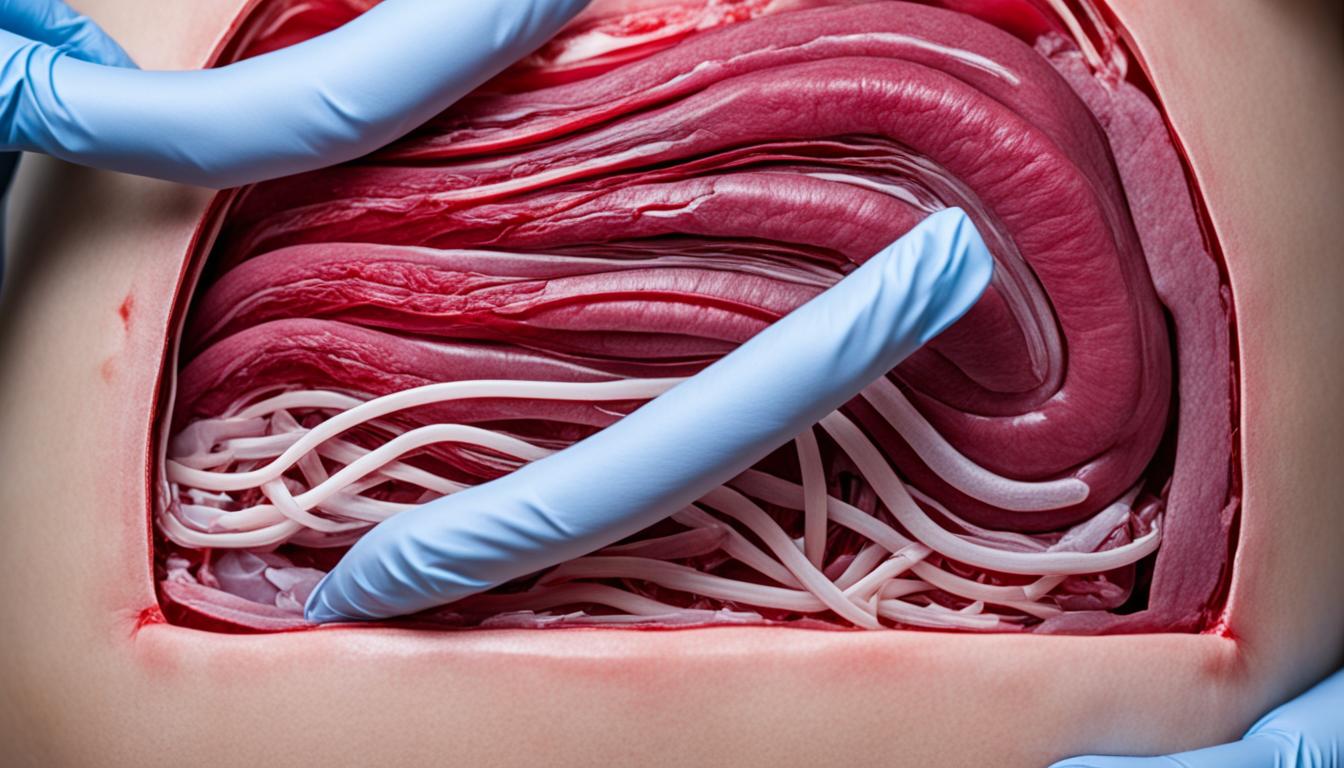Celiac artery compression syndrome affects a big blood vessel in the belly called the celiac artery. It provides oxygen-rich blood to organs like the liver, stomach, and spleen.
The syndrome happens when the celiac artery is squeezed by a band of tissue. This tissue, called the median arcuate ligament, sits in the upper belly.
It can cause several signs and issues, including:
- Abdominal pain
- Digestion issues
- Abdominal bruit (a whooshing sound heard over the abdomen)
- Weight loss
The exact cause of this syndrome is not clear. It seems to be linked to how the median arcuate ligament is placed. This can press on the celiac artery, reducing blood flow and causing symptoms.
To diagnose this condition, doctors use tests like ultrasound or CT scans. These show if the celiac artery is being squeezed or blocked.
Treating this syndrome depends on how bad the symptoms are. For mild cases, doctors may suggest medicine or lifestyle changes. They might also use procedures like angioplasty to open the artery more.
If symptoms are severe, someone might need surgery. This can involve freeing the artery or creating a bypass around the blockage.
Key Takeaways:
- Celiac artery compression syndrome is characterized by the compression of the celiac artery by the median arcuate ligament.
- Symptoms of celiac artery compression syndrome include abdominal pain, digestion issues, abdominal bruit, and weight loss.
- Diagnosis involves imaging studies to visualize the celiac artery and assess for compression.
- Treatment options range from medication management and lifestyle changes to minimally invasive procedures or surgical intervention.
- Further research is needed to better understand the prevalence and long-term outcomes of celiac artery compression syndrome.
Prevalence of Celiac Artery Compression Syndrome and its Association with Other Conditions
Celiac artery compression syndrome is a rare condition, affecting less than 1% of people. Despite its low numbers, some individuals are more likely to get it. This includes those with a family history of the syndrome or who have faced abdominal injuries.
It’s also linked to atherosclerosis, a condition where artery plaque builds up. This link is crucial. It shows how the state of the arteries may play a part in the syndrome’s development.
Finding out they have celiac artery compression syndrome might also mean being at risk for other health issues. For instance, it could lead to poor blood flow to the intestines or a narrowing of the arteries that feed the kidneys. The exact connection is still unclear and needs more study.
Knowing about this condition and its links to other health problems is key for doctors. It helps them provide better care and find the right treatments. But, more research is necessary. We still need to understand fully how celiac artery compression syndrome is connected to these other health conditions.
Diagnosis and Management of Celiac Artery Compression Syndrome
Celiac artery compression syndrome is known as median arcuate ligament syndrome (MALS). It causes issues like stomach pain, trouble digesting, and loss of weight. It’s important to find and treat it well to help people feel better.
Doctors first take a detailed look at a patient’s medical history and give them a physical exam to find MALS. Common signs are stomach pain after eating, a strange noise in the stomach, and losing weight for no clear reason. But, these signs are not enough to be sure of the diagnosis.
Tests that show pictures inside the body are key to spotting MALS. Things like ultrasounds, CT scans, and MRIs help check the celiac artery for any squeezing from a tight ligament.
If MALS is mild, doctors may suggest changing diet and daily habits to see if that helps. This includes eating better, staying away from certain foods, and keeping a healthy weight. They might also give medications to ease the pain or lower any swelling.
For more serious MALS that doesn’t get better with easy fixes, surgery might be the best option. The two main types are releasing the celiac artery or bypassing it. Releasing the artery involves lifting the tight ligament off it. Bypass surgery makes a new way for blood to flow.
Living with MALS means teaming up with different kinds of doctors and a dietitian. They work together to create a plan that suits the patient best. Keeping track and seeing the doctors often will tell if the plan is working or if changes are needed.
By finding and treating MALS well, doctors can help their patients live better and lower the pain and other issues this disease brings.
Conclusion
Celiac artery compression syndrome is a rare problem. It happens when the celiac artery is squeezed by a ligament. This can bring on tummy pain, issues with food digestion, and losing weight. Doctors use imaging tests to see the artery and how much it’s being compressed.
The treatment differs based on how bad the symptoms are and how much the artery is squished. For light cases, doing things like changing your lifestyle and taking meds might help. But, surgery might be needed in serious cases. Procedures like releasing the artery or a bypass can fix the blood flow issue.
Even though this syndrome doesn’t happen much, we need to know more about it. More research could show how common it is, what raises the risks, and the results over time. Studying this more can help doctors find better ways to spot and treat it. This could make life better for those dealing with celiac artery compression syndrome.

